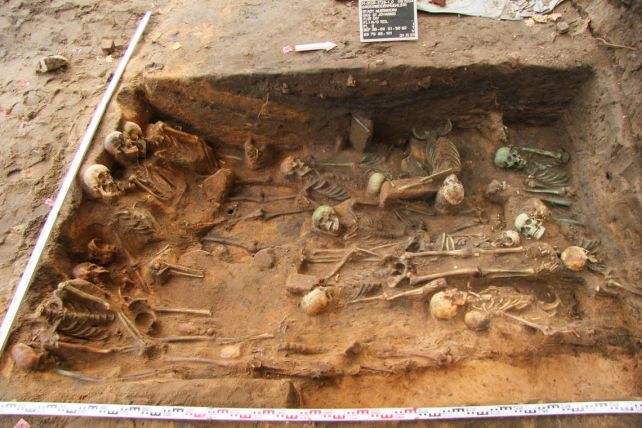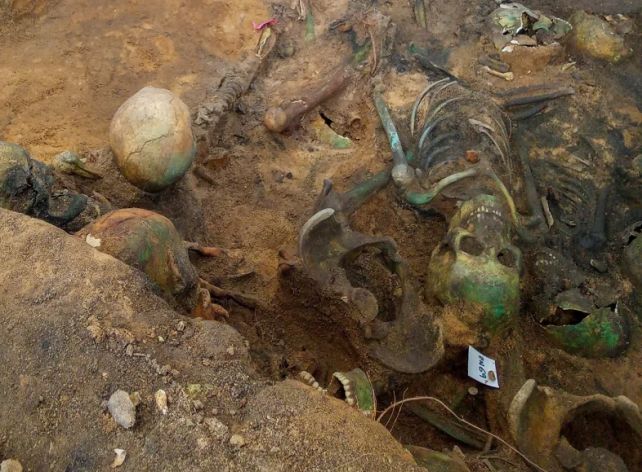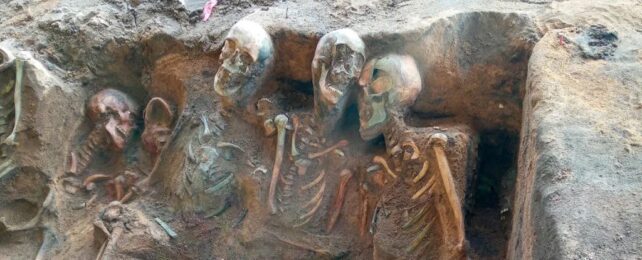Archaeologists digging in the German city of Nuremberg ahead of the construction of a new retirement home have uncovered what may be the largest mass burial of plague victims ever uncovered in Europe.
Excavations are ongoing, but the centuries-old remains of more than 500 individuals have been unearthed so far, and the team believes there could have been as many as 1,500 people interred therein.
Precise dating is also yet to be performed, but tentative estimates suggest the eight plague pits were created around the first half of the 17th century. Some of the bones appear tinted green because for some time the site was used to dispose of waste from a nearby copper mill, Spiegel reports.
"We will secure and archive all human remains that are found in the future construction areas," says Nuremberg Department of Heritage Conservation archaeologist Melanie Langbein and chief anthropologist Florian Melzer.
"We currently assume that once the work is completed in the spring, this will be the largest emergency cemetery for plague victims excavated in Europe."

Bubonic plague has been associated with many of history's most devastating pandemics, chiefly the Black Death of the 14th century and the Justinian plague that kicked off in the 6th century. Yet the highly contagious, flea-borne infection reemerged frequently in smaller outbreaks through the ages. Following the Black Death in Europe, local epidemics recurred for around 400 years, ravaging cities.
Nuremberg was no exception. The city even has a famous dedicated plague cemetery, St. Rochus. But what archaeologists from In Terra Veritas found while performing what they assumed was a routine diligence check ahead of construction was no cemetery. The silent bones spoke of something far more desperate and devastating.
"Those people were not interred in a regular cemetery although we have designated plague cemeteries in Nuremberg," Langbein told Jack Guy at CNN. "This means a large number of dead people who needed to be buried in a short time frame without regard to Christian burial practices."
Plague leaves no visible traces on the bones of its victims, so more work will need to be done to confirm the diagnosis. A DNA analysis of the bones is expected to confirm the traces of the plague bacterium Yersinia pestis. But several lines of dating point to plague as the most likely explanation.

Radiocarbon dating on remains from one of the graves dates it to between the late 15th to early 17th centuries, and coins and pieces of pottery found therein point to the early 20th century. They also found a note dated 1634 describing a plague outbreak in 1632 and 1633 in Nuremberg that killed a reported 15,000 people.
Some 2,000 of those, the note said, were buried at the site of the current excavation.
But the implications of the discovery far exceed the manner in which the individuals died. All of the remains will need to be excavated, and carefully relocated so that scientists can study them, for a unique snapshot of the history of Nuremberg.
"This discovery is of great significance far beyond the region," said Nuremberg Lord Mayor Marcus König.
"The graves contain the mortal remains of children and old people, men and women; the plague did not stop at gender, age or social status. Now, for the first time, an empirically reliable analysis of a large population group from this period can be carried out for a city with the importance of Nuremberg. It goes without saying that this historically and archaeologically significant find must be handled sensitively and appropriately."
